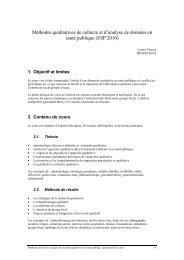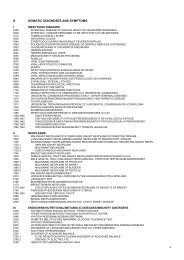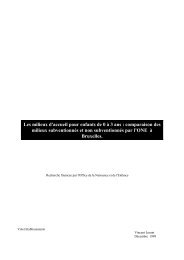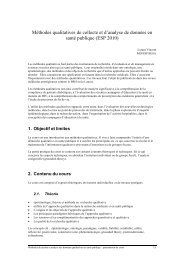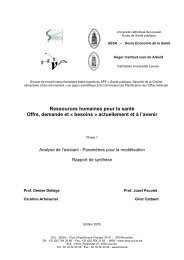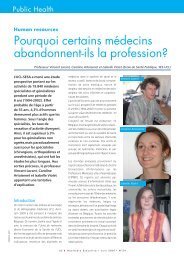MCI - Sesa
MCI - Sesa
MCI - Sesa
You also want an ePaper? Increase the reach of your titles
YUMPU automatically turns print PDFs into web optimized ePapers that Google loves.
Université Catholique de Louvain<br />
Cliniques Universitaires Saint-Luc<br />
Les troubles cognitifs légers<br />
(mild cognitive impairment – <strong>MCI</strong>)<br />
Dr. Adrian Ivanoiu<br />
Service de Neurologie<br />
• Clinique de la Mémoire<br />
• Centre de Revalidation Neuropsychologique
“ Alzheimer’s disease is when the<br />
patient was older and less intelligent<br />
than the doctor ”<br />
British Medical Journal in 1981<br />
(in Mariani, 2004)
Mild cognitive impairment : what are we talking about ?<br />
epidemiological studies<br />
Memory Clinics experience<br />
Portrait « robot » :<br />
memory complaints<br />
+/- confirmed by relatives<br />
low performer (especially on memory tasks)<br />
preserved autonomy = not demented
Mild cognitive impairment - <strong>MCI</strong><br />
“those elderly subjects with mild cognitive changes but<br />
judged to be non demented”<br />
Flicker C, Ferris SH, Reisberg B. Mild cognitive impairment in the elderly: predictors of<br />
dementia. Neurology. 1991 Jul;41(7):1006-9.<br />
the Mayo Clinic conception : a risk state for future<br />
dementia<br />
Petersen RC, Smith GE, Waring SC, Ivnik RJ, Tangalos EG, Kokmen E. Mild cognitive<br />
impairment. Clinical characterization and outcome. Arch Neurol 1999;56:303-308.<br />
=> diagnostic criteria
Mild Cognitive Impairment (<strong>MCI</strong>)<br />
<strong>MCI</strong> → AD 12%/yr<br />
±75 % after 5 yr<br />
Control → AD 1-2%/yr1<br />
100<br />
100<br />
90<br />
90<br />
80<br />
80<br />
70<br />
70<br />
60<br />
60<br />
50<br />
Initial 12 24 36 48<br />
exam<br />
Months<br />
50<br />
Initial 12 24 36 48<br />
exam<br />
Months<br />
<strong>MCI</strong> AD<br />
Controls AD<br />
Petersen et al. Mild cognitive impairment. Clinical characterization and outcome. Arch Neurol 1999;56:303-308
Heterogeneity of the clinical presentation of <strong>MCI</strong> and<br />
potential multiple etiologies<br />
Clinical presentation<br />
<strong>MCI</strong><br />
Amnestic<br />
<strong>MCI</strong><br />
Multiple Domains<br />
<strong>MCI</strong><br />
Single Non-memory<br />
Domain<br />
Possible etiologies<br />
Degenerative<br />
Vascular<br />
Metabolic<br />
Traumatic<br />
Psychiatric<br />
Others ?<br />
AD<br />
From: Winblad et al. Mild cognitive impairment - beyond controversies, towards a consensus: report of the<br />
International Working Group on Mild Cognitive Impairment. J Intern Med. 2004 Sep; 256(3): 240-6.
New criteria : disease centered<br />
(amnestic) <strong>MCI</strong> => full established AD<br />
predemential => dementia<br />
Alzheimer’s disease
Core diagnostic criteria : episodic memory impairment<br />
gradual & progressive > 6 months<br />
objective memory deficits => suggestive of an encoding deficit<br />
isolated OR ass. other cognitive deficits<br />
Supportive features : one or more<br />
‣ medial temporal atrophy<br />
‣ abnormal cerebrospinal fluid biomarker<br />
‣ specific pattern of functional neuroimaging with PET<br />
‣ proven AD mutation within the family
Preliminary question :<br />
When starts the <strong>MCI</strong> ?<br />
(AD ?)
Low memory & cognitive performance<br />
‣ hereditary AD studies : 5 – 10 years<br />
‣ epidemiological cohorts :<br />
Framingham cohort (Elias, 2000) : > 10 ans
Patient CP<br />
male, 73 years old, architect. No memory complaints.<br />
1995: control for his wife with AD in a research.<br />
MMSE 29/30; BIMC 4/28 (Nl: < 8/28)<br />
The 1995 memory evaluation (immediate free recall of 10 words in 6 trials)<br />
Z-sc M sec<br />
2,5<br />
2<br />
1,5<br />
1<br />
,5<br />
0<br />
-,5<br />
-1<br />
-1,5<br />
Ctrl âgé<br />
Alzheimer<br />
Patient CP<br />
30<br />
28<br />
26<br />
24<br />
22<br />
20<br />
Cas CP - evolution du MMSE sur 6 ans<br />
1st cognitive<br />
complaints<br />
95 98 99 00 01<br />
dementia<br />
MMSE (CP)<br />
sup<br />
inf<br />
-2<br />
-3 -2,5 -2 -1,5 -1 -,5 0 ,5 1 1,5 2 2,5<br />
Z-sc M tot
Clinique de la Mémoire Saint Luc<br />
de 1994 à 2004<br />
age 50-79 ans : 1061 patients<br />
‣ 46% Démences (66% Alzheimer)<br />
‣ 11 % Autres (trauma, épilepsie etc...)<br />
‣ 11% <strong>MCI</strong><br />
‣ 32% Pas déments<br />
74 patients<br />
31,2%<br />
déments avérés<br />
ou suspects
Diagnostic initial<br />
Parmi les 74 => déments & suspects<br />
‣ 47% => <strong>MCI</strong><br />
59% amnesique<br />
12% autre domain<br />
29% multiples domains<br />
‣ 49% => anxio-depréssifs<br />
‣ 4% « normaux »
Is it only a memory problem ?<br />
- The Nun Study -<br />
David Snowdon, epidemiologist at the University of Kentucky medical center<br />
678 women from religious orders<br />
Idea density in early autobiographies ≈ AD late in life<br />
(= nb. ideas expressed / 10 words)<br />
90 % of AD brains<br />
13 % without AD brains<br />
=> low density group<br />
Snowdon, Kemper, Mortimer, Greiner, Wekstein & Markesbury (1996)
When starts Alzheimer’s disease ?<br />
Nl<br />
22 %<br />
healthy<br />
56 %<br />
asymptomatic ? preclinical ?<br />
An<br />
16 %<br />
6 %<br />
memory only => <strong>MCI</strong><br />
dementia => AD<br />
*From Braak et al. “Neuropathology of Alzheimer’s disease: what is new since A. Alzheimer? Eur Arch Psychiatry Clin Neurosci (1999)
Question :<br />
Does the memory impairment in<br />
amnestic <strong>MCI</strong> has anything specific ?
Alzheimer’s disease : an “amnestic dementia”<br />
⇓ memory for recent events :<br />
= episodic memory : memory for events<br />
personally experienced in spatio-temporal context<br />
Tulving, 1972; Schacter & Tulving, 1994; Wheeler et al., 1997; Tulving, 1999<br />
memory impairment in early AD :<br />
= of “hippocampal type”<br />
Dubois & Albert. Lancet Neurol. 2004 Apr;3(4):246-8.
The most fundamental deficit in AD<br />
a reduced capacity to learn new information<br />
Salmon and Bondi, (1999), Kertesz and Mohs, (1999), Becker et al., (1996)<br />
x<br />
encoding<br />
retrieval<br />
test<br />
the best predictor of future dementia<br />
= free delayed recall<br />
Welsh et al., 1991; Morris et al, 1991; Locascio et al, 1995; Albert, 1996; Grober<br />
et al., 2000
x<br />
encoding<br />
retrieval<br />
test<br />
non mnesic confounding factors :<br />
inattention, poor strategy, fatigue, low education, anxiety,<br />
depression ...<br />
=> apparent memory deficits<br />
AD<br />
Ctrls<br />
Classical memory test<br />
(delayed recall)<br />
overlap<br />
=> poor diagnostic validity
La RL/RI16 (rappel libre / indicé 16)<br />
4 consecutive boards<br />
x 4 items : encoded in relationship with<br />
semantic cues (categories)<br />
Free, then Cued recall for the remaining<br />
items with the<br />
same semantic cues<br />
dentiste<br />
dentiste<br />
groseille<br />
dentiste<br />
groseille<br />
dentiste<br />
groseille<br />
groseille<br />
cuivre<br />
cuivre<br />
harpe<br />
cuivre<br />
harpe<br />
cuivre<br />
harpe<br />
harpe<br />
20 s<br />
• which were the insects ?<br />
• which were the fruits ?<br />
• which were the metals ?<br />
controlled<br />
encoding / retrieval<br />
conditions<br />
AD<br />
Ctrls<br />
Maximise the recall +<br />
minimise the confounding<br />
factors<br />
=> increases the difference<br />
in recall by cases and<br />
controls
La RL/RI16 (rappel libre / indicé 16)<br />
Population<br />
CTR<br />
TCL<br />
DTAlég<br />
DTAlmod<br />
Nombre<br />
69<br />
68<br />
61<br />
66<br />
Âge<br />
72(7,6)<br />
73,4(5,8)<br />
73,2(6,7)<br />
72,3(7,7)<br />
Sexe (% F)<br />
60<br />
53<br />
62<br />
67<br />
NSC % 1/2/3 #<br />
37/29/34<br />
22/32/46<br />
38/26/36<br />
47/36/17 a,b,c<br />
MMSE (0 – 30)<br />
*<br />
–<br />
27,1(1,7)<br />
25,7(1,3) b<br />
20,6(2,6) b,c<br />
Ivanoiu, Alves, Grégoire, Seron – en préparation
<strong>MCI</strong> mildAD modAD<br />
sensitivity % / specificity %*<br />
71/79<br />
ou<br />
82/68<br />
85/92<br />
ou<br />
92/86<br />
92/92<br />
ou<br />
95/86<br />
* total of free recall (1+2+3)
The RI-48 Test = “Rappel Indicé 48 items”<br />
By Ivanoiu et al., 2004; Adam et al., 2004; according to Buschke, 1997<br />
Population<br />
Agés<br />
normaux<br />
Anxiodépressifs<br />
<strong>MCI</strong><br />
MA<br />
légers<br />
Nb<br />
38 25 29 24<br />
Age 71(8) 69(6) 71(6) 73(4)<br />
MMSE<br />
28.1(1.8) 28.7(1.3) 26.7(1.7) 23.0(2.6)<br />
Ivanoiu et al., J Neurol, 2000 & 2005
The RI-48 Test = “Rappel Indicé 48 items”<br />
By Ivanoiu et al., 2004; Adam et al., 2004; according to Buschke, 1997<br />
1,0<br />
0,9<br />
0,8<br />
0,7<br />
0,6<br />
0,5<br />
0,4<br />
0,3<br />
0,2<br />
RI 48<br />
CERAD-recall<br />
CERADdelayed<br />
recall<br />
MMSE<br />
0,1<br />
0,0<br />
0,0 0,1 0,2 0,3 0,4 0,5 0,6 0,7 0,8 0,9 1,0<br />
1 - Specificity<br />
Ivanoiu et al., J Neurol; 2005
A careful optimisation of the encoding phase = crucial<br />
for a good discrimiation between cases and controls<br />
=> the more encoding specificity is accentuated the<br />
more discriminating power is increased for the diagnosis<br />
of very mild AD
Comparison between items with low and high<br />
encoding specificity optimisation<br />
(a) High specificity : % items = encoded at the first trial (DCRa)<br />
(b) Low specificity : % items = a min of two trials necessary (DCRb)
L’effet de la maladie d’Alzheimer sur la<br />
performance à un test de mémoire<br />
90<br />
80<br />
Test RL/RI 16<br />
70<br />
60<br />
sujets normaux<br />
%<br />
50<br />
40<br />
30<br />
20<br />
10<br />
Effet de l’âge :<br />
- 6% tous les<br />
10 ans<br />
tr. cognitifs légers<br />
Alzheimer léger<br />
Alz. modéré<br />
0<br />
RLT%48<br />
Effet de la maladie d’Alzheimer<br />
Sujets<br />
age 70-79<br />
tr. cognitif léger<br />
Alzheimer léger<br />
Alzheimer modéré<br />
% perf<br />
100<br />
64<br />
42<br />
30<br />
perte%/ s. âgés<br />
-36<br />
-58<br />
-70<br />
éq.âge (-6%)<br />
115 ans<br />
140 ans<br />
150 ans
A psychometric dilemma ...<br />
A cognitive measure<br />
The cut-off<br />
-2SD<br />
(2.5 pc)<br />
is<br />
here<br />
<strong>MCI</strong> diagnosis<br />
should<br />
be here<br />
An Nl An Nl
animal - vache<br />
animal - cheval<br />
animal - mouton<br />
animal - chèvre<br />
interférence proactive<br />
%<br />
,7<br />
,65<br />
,6<br />
,55<br />
,5<br />
,45<br />
,4<br />
PT1 PT2 PT3 PT4<br />
%<br />
,8<br />
,75<br />
,7<br />
,65<br />
,6<br />
,55<br />
,5<br />
,45<br />
,4<br />
,35<br />
,3<br />
,25<br />
HC<br />
<strong>MCI</strong><br />
PT1 PT2 PT3 PT4
Healthy controls vs.<br />
<strong>MCI</strong> - all<br />
Matched healthy controls vs.<br />
<strong>MCI</strong> – normal performance<br />
0<br />
0<br />
-,05<br />
-,05<br />
z-scores<br />
-,1<br />
-,15<br />
z-scores<br />
-,1<br />
-,15<br />
-,2<br />
-,2<br />
-,25<br />
-,3<br />
-,25<br />
Dif PT<br />
-,35<br />
Dif PT<br />
HC<br />
<strong>MCI</strong><br />
p = ns<br />
p = 0.0025
Question :<br />
Are the CSF biomarkers useful ?
Aucun marqueur n’est actuellement en phase<br />
d’utilisation clinique courante !<br />
Les plus prometteurs :<br />
Le dosage du :<br />
β-amyloïde 1-42<br />
protéine TAU<br />
phosho-TAU<br />
dans le LCR
La neuropathologie de la maladie d’Alzheimer<br />
Plaques séniles (PS)<br />
= peptide<br />
β amyloïde 1-42 (Aβ-42)<br />
Dégénéréscences<br />
neurofibrillaires (DNF)<br />
= protéine TAU hyperphosphorylée<br />
Blennow K. CSF<br />
biomarkers for<br />
Alzheimer's disease:<br />
use in early diagnosis<br />
and evaluation of drug<br />
treatment. Expert Rev<br />
Mol Diagn. 2005<br />
Sep;5(5):661-72.<br />
provient du clivage de l’Amyloid<br />
Precursor Protein (APP) = protéine<br />
transmembranaire<br />
APP = rôle inconnu (plasticité ?)<br />
protéine associée au système<br />
microtubulaire & transport<br />
intracellulaire<br />
surtout ds les axones
Phospho-tau<br />
Neurofibrillary<br />
tangles<br />
Tau<br />
Neuronal and<br />
axonal damage<br />
ß-Amyloid<br />
β-amyloid deposition /<br />
senile plaques<br />
Ph<br />
TAU<br />
TAU<br />
β42<br />
disorders<br />
with hyper<br />
Ph TAU<br />
CSF<br />
all<br />
axonal<br />
damage<br />
CSF<br />
sequestration<br />
in plaques<br />
??<br />
⇓ production<br />
clearance
La méthode combinée (Seubert, 1997; Galasko, 1997)<br />
Protéine TAU OU amyloïde Aβ 1-42<br />
cc. trop élévée<br />
cc. trop faible<br />
sensibilité = 85% / spécificité = 87%<br />
Hulstaert F, Blennow K, Ivanoiu A, et al. Improved discrimination of AD patients using beta-amyloid<br />
(1-42) and tau levels in CSF. Neurology 1999 May 12;52(8):1555-62
Blennow K.<br />
CSF biomarkers for Alzheimer's disease: use in early diagnosis and evaluation of<br />
drug treatment.<br />
Expert Rev Mol Diagn. 2005 Sep;5(5):661-72.<br />
Review of significant studies (evidence-based approach)<br />
Aβ42 : 6 studies (300 AD / 200 Ctrls)<br />
sensitivity 89% / specificity 90%<br />
TAU protein : 10 studies (800 AD / 300 Ctrls)<br />
sensitivity 84% / specificity 91%<br />
phTAU protein : 11 studies<br />
sensitivity 81% / specificity 92%
Blennow K, Hampel H.<br />
CSF markers for incipient Alzheimer's disease.<br />
Lancet Neurol 2003;10: 605-13.<br />
Review of significant studies (evidence-based approach)<br />
Focus on :<br />
mild dementia (MMSE > 23) = 7 studies<br />
mild cognitive impairment (<strong>MCI</strong>) = 14 studies<br />
sensitivities / specificities for Aβ42, TAU and phTAU<br />
= similar to those found in more advanced AD<br />
⇒ positive very early in AD<br />
⇒ useful for early diagnosis
28 <strong>MCI</strong> / 75 AD / 38 normal aged / 17 anxio-depressed<br />
Sensitivity (%) Specificity (%)<br />
<strong>MCI</strong> prAD / Anx / AC<br />
TAU protein only 50 53 94 -<br />
Amyloid β42 only 61 64 94 -<br />
Combination of biomarkers 86 88 76 84
CSF biomarkers and cognitive measures are predictors of<br />
evolution in mild cognitive impairment<br />
Auriane Speth, Francis Zech, Christian JM Sindic, Xavier Seron and<br />
Adrian Ivanoiu<br />
Mild<br />
cognitive impairment<br />
Mild<br />
Alzheimer<br />
Disease<br />
all stable evolving<br />
Number 48 24 24 47<br />
Age /years 71.0 (5.3) 70.8 (5.2) 71.2 (5.6) 71.4 (7.6)<br />
Sex (% M) 54.2 75 33 a 38.3<br />
Education % 1/2 # 50/50 33/67 67/33 a 60/40
Results:<br />
The CSF Aβ42, the MMSE and the verbal<br />
memory were predictors of an evolution towards<br />
AD (75% of patients correctly classified)<br />
Aβ42 = correlated with the MMSE, the Animal<br />
Fluency and the Trail Making Test<br />
TAU protein = correlated only with the memory<br />
scores, independently of the outcome
Hypothesis :<br />
CSF Aβ42 = predictor of an evolution to<br />
AD in <strong>MCI</strong><br />
CSF TAU protein level = reflects the<br />
amount of medio-temporal damage<br />
resulting in amnesia
Question :<br />
Are the imaging techniques useful ?
Morphological imagery markers<br />
2<br />
1<br />
1. sillons plus creusés<br />
2. ventricules plus larges<br />
1. hippocampe plus petit<br />
2. corne ventriculaire plus large
Homme, 72 ans, publicitaire : plainte mnésique depuis 2 ans<br />
<strong>MCI</strong><br />
1999 2001<br />
Demence légère<br />
droite gauche
Un cas de maladie d’Alzheimer<br />
Sœur M, une religieuse de 76 ans ...<br />
1997<br />
27/30<br />
2002<br />
6/30
Functional imagery markers<br />
"Ever since the original reports, the PET and SPECT findings ... have been<br />
debated in terms of diagnostic utility" (Jagust, 1999 )<br />
"SPECT was an established technique for supporting the<br />
clinical diagnosis of AD"<br />
Alzheimer<br />
Therapeutics and Technology Assessment Subcommittee of the<br />
American Academy of Neurology. Assessment of brain SPECT.<br />
Neurology 1996;46:278-285.2.<br />
"The dementia practice parameters : SPECT is an<br />
optional part of the dementia evaluation"<br />
Quality Standards Subcommittee of the American Academy of<br />
Neurology. Practice parameters for diagnosis and evaluation of<br />
dementia (summary statement). Neurology 1994;44:<br />
SPECT = PET (Jagust, 1999 )
Hoffman et al., FDG PET imaging in patients with pathologically<br />
verified dementia. J Nucl Med 2000;41; 1920-8<br />
sensitivity / specificity of the temporo-parietal hypometabolism<br />
(against healthy individuals) : 63 / 82 %<br />
sensitivity / specificity of the NINCDS-ADRDA clinical criteria<br />
(against healthy individuals) : 63 / 100 %<br />
Kantarci & Jack. Neuroimaging in Alzheimer disease : an evidencebased<br />
review. Neuroimage Clin N Am 13 (2003), 197-209<br />
”there is ... evidence that diagnostic accuracy of either SPECT or PET is not<br />
higher than the clinical criteria in AD. Nontheless, ... appear promising for<br />
differentiating other dementia syndromes [such as ] frontotemporal dementia<br />
and Lewy bodies dementia from AD”
In-vivo<br />
visualisation<br />
of amyloïd<br />
“Pittsburgh Compound B”<br />
Klunk et al. Imaging brain amyloid in Alzheimer's disease with Pittsburgh Compound-B. Ann<br />
Neurol. 2004 Mar;55(3):306-19.
Klunk et al. Imaging brain amyloid in Alzheimer's disease with<br />
Pittsburgh Compound-B. Ann Neurol. 2004 Mar;55(3):306-19.<br />
in 16 patients with mild AD and 9 controls<br />
PIB retention increased in AD :<br />
frontal cortex > striatum > parietal > temporal = occipital<br />
no significant group differences between young (3) and older<br />
controls (6)<br />
PIB retention correlated inversely with cerebral glucose<br />
metabolism determined with 18F-fluorodeoxyglucose
Fagan et al., Inverse relation between in vivo amyloid imaging<br />
load and cerebrospinal fluid Abeta42 in humans. Ann Neurol. 2006<br />
Mar;59(3):512-9.<br />
brain amyloid deposition results in low CSF Abeta(42)<br />
three cognitively normal subjects were PIB-positive with low CSF<br />
Abeta(42)<br />
Mintun et al., [11C]PIB in a nondemented population: potential<br />
antecedent marker of Alzheimer disease. Neurology. 2006 Aug<br />
8;67(3):446-52.<br />
Four of the 41 nondemented subjects had elevated cortical BP<br />
values and their BP values as a group were not significantly<br />
different from the DAT subjects
Remerciements<br />
Clinique<br />
• Pr. Eric Constant<br />
• Neuropsy./logopèdes<br />
Centre Reval. Npsy. St<br />
Luc<br />
Faculté<br />
• Xavier Seron<br />
• Unités NESC & CODE<br />
Fac Psy LLN<br />
Doctorands<br />
• Auriane Speth<br />
• Bernard Hanseeuw<br />
• Charlotte Rensonnet<br />
Etudiants<br />
• Marie Wertz<br />
• Violette de Ryck



